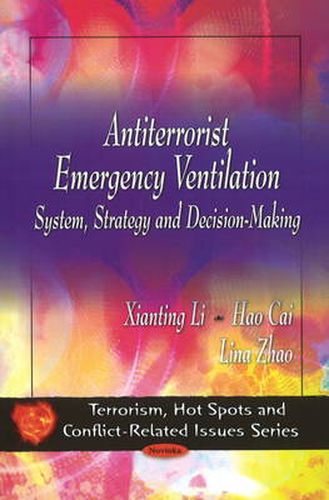Readings Newsletter
Become a Readings Member to make your shopping experience even easier.
Sign in or sign up for free!
You’re not far away from qualifying for FREE standard shipping within Australia
You’ve qualified for FREE standard shipping within Australia
The cart is loading…






There are two kinds of antiterrorist emergency ventilation system. One is to defend indoor environment against chemical and biological agent (CBA) attacks. The other is to supply calmative gas to incapacitate terrorists when they hold hostages in public buildings. What kind of system and ventilation strategy can be used for antiterrorism, and how to make decision are introduced in the book. There are six sections in the book. How the emergency ventilation systems work is introduced in the first section. The second section is on the theory of contaminant dispersion and identification of contaminant source. For the theory of contaminant dispersion, both computational fluid dynamics (CFD) method and analytical formula of contaminant distribution are introduced. For the theory of contaminant source identification, an algorithm to identify the position and intensity of contaminant source with limited number of sensors is proposed and demonstrated for its effectiveness. The third section is on the evacuation model and evaluation of exposure risk. Both cellular automata (CA) model and spatial-grid evacuation model (SGEM) are introduced for modelling evacuation process. The relative exposure risk index, EFCS, and absolute exposure risk index, PIR, are introduced to evaluate the exposure risk of contaminant. Both the second section and third section are the fundamental of emergency ventilation. Based on section 2 and 3, the ventilation strategy and decision-making are introduced for emergency ventilation against contaminant suddenly released in public building in section 4 and for emergency ventilation to rescue hostages held by terrorists in section 5, respectively. Section 6 is the summary of the whole book.
$9.00 standard shipping within Australia
FREE standard shipping within Australia for orders over $100.00
Express & International shipping calculated at checkout
There are two kinds of antiterrorist emergency ventilation system. One is to defend indoor environment against chemical and biological agent (CBA) attacks. The other is to supply calmative gas to incapacitate terrorists when they hold hostages in public buildings. What kind of system and ventilation strategy can be used for antiterrorism, and how to make decision are introduced in the book. There are six sections in the book. How the emergency ventilation systems work is introduced in the first section. The second section is on the theory of contaminant dispersion and identification of contaminant source. For the theory of contaminant dispersion, both computational fluid dynamics (CFD) method and analytical formula of contaminant distribution are introduced. For the theory of contaminant source identification, an algorithm to identify the position and intensity of contaminant source with limited number of sensors is proposed and demonstrated for its effectiveness. The third section is on the evacuation model and evaluation of exposure risk. Both cellular automata (CA) model and spatial-grid evacuation model (SGEM) are introduced for modelling evacuation process. The relative exposure risk index, EFCS, and absolute exposure risk index, PIR, are introduced to evaluate the exposure risk of contaminant. Both the second section and third section are the fundamental of emergency ventilation. Based on section 2 and 3, the ventilation strategy and decision-making are introduced for emergency ventilation against contaminant suddenly released in public building in section 4 and for emergency ventilation to rescue hostages held by terrorists in section 5, respectively. Section 6 is the summary of the whole book.